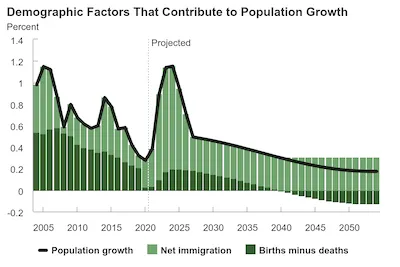America’s Fertility Decline: Crisis or Economic Constraint?

U.S. fertility has been in long-term decline since the end of the Baby Boom (1946–1964). From 1965 onward, the total fertility rate fluctuated between 1.7 and 2.1 births per woman — until 2007, when it began a sustained 15-year drop. By 2021, the rate had hit a historic low of 1.64 births per woman, the lowest in over 80 years.
Measured differently, this means births per 1,000 women declined from a post-Baby Boom average of 68 to just 56 by 2022.
Why Is Fertility Falling?
No single factor explains this decline, but several trends shed light on what's happening:
Teen birth rates, once a key factor in lowering fertility, had already fallen significantly by 2007 and no longer explain the continued drop.

Fertility intentions — the number of children women say they want — have not fallen nearly as much as actual fertility. This suggests that the drop may reflect delay more than permanent deferral.
Evidence of Delay
The number of children ever born to women aged 40–44 has remained relatively stable since 1990.
Age-specific fertility shows a shift: Births are down for women in their 20s, flat for early 30s, but rising for women in their late 30s and early 40s.
Other life milestones — marriage, homeownership — are also occurring later in life, consistent with delayed fertility.
The Role of Economics
The evidence increasingly points to economic constraints as a major factor:
American Compass (2021): Half of families did not meet their desired number of children; one-third of working- and middle-class families cited cost as the reason.
New York Times Poll: 64% of parents not having more children cited childcare cost as a major barrier.
There’s also the broader issue of economic confidence. Families aren’t just worried about today’s costs — they’re unsure whether they can offer their children a secure future. That uncertainty is hard to quantify but deeply impactful.
Consider:
Only 50% of Americans born in the 1980s earned more than their parents by age 30 — compared to 80–90% in previous generations.
Since 2000, the U.S. has been in a “recession jobs deficit” for 57% of all months, meaning most of the time the labor market hasn’t even returned to pre-recession strength.
Fertility Policy: Targeting the Real Constraints
If Americans still want children, but feel they can’t afford them, policy should aim not to change preferences — but circumstances.
There are two primary categories of economic constraint:
1. Out-of-Pocket Cost of Childbirth
The average out-of-pocket cost of delivery for those with private insurance is $2,854.
Assisted reproduction, which affects 1 in 5 women trying to conceive, can cost $16,000 or more per transfer and isn’t covered in all states.
Many mothers lose income during recovery, and some lose their jobs if they’re not covered by the Family and Medical Leave Act (FMLA).
2. Labor Market Penalties for Mothers
The so-called “child penalty” — a 20–30% reduction in lifetime earnings — hits many mothers after childbirth.
Few employers are required to offer schedule flexibility or accommodations.
Childcare is often as expensive as a mortgage, yet underfunded and hard to access.
Some women choose to leave the workforce not out of preference, but because continuing to work becomes unsustainable.
Building a Fertility-Friendly Infrastructure
To reduce these barriers, a targeted set of policies could reshape the economic conditions under which Americans choose to start or expand their families.
A Final Word on Maternal Health
No discussion of fertility is complete without acknowledging the maternal health crisis in America. In 2021, maternal mortality rose to 32.9 deaths per 100,000 live births — nearly double the rate from 2018. It is now 3 to 10 times higher than peer nations in Europe. This is not just alarming — it’s a public health emergency.
Conclusion: Fertility Is About Choices, Not Just Preferences
The fertility decline in the U.S. isn’t driven by people wanting fewer children. It’s about people feeling unable to have the children they want.
Whether due to rising costs, economic instability, lack of support, or labor market penalties, the message is clear: Fertility in the U.S. is being shaped by policy gaps, not just personal preferences.
We cannot legislate fertility preferences — but we can change the conditions in which families make those choices.
